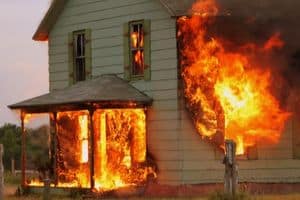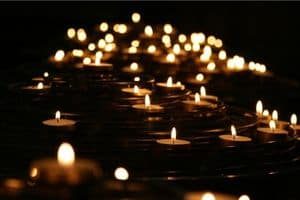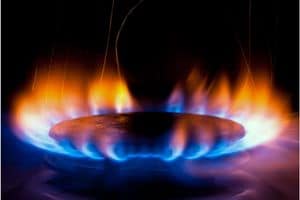There are approximately 358,000 structure fires in homes every single year. Many of these fires lead to deaths, with 3,000 Americans perishing annually from fire. An ounce of prevention can be worth a pound of cure. What causes house fires?

Here are the leading house fire causes:
- Cooking
- Heating
- Electrical
- Smoking
- Candles
- Holiday decorations
- Gasses and chemicals
- Lightning
- Grilling
In today’s informative article, we’ll delve into the above 9 causes of house fires and share some of our top safety tips so you and your family can stay out of harm’s way!
9 Leading Causes of Fire
Let’s begin by covering the most frequent culprits for house fires. The National Fire Protection Association (NFPA) ranked many of these causes.
Cooking
At the top of the list of house fire causes is cooking. In fact, I have been or more fires caused by cooking than anything else.
According to the NFPA, between 2015 and 2019, cooking led to the most home fires and the most injuries from home fires. It was also the second largest contributor to fire deaths in that period.
From 2015 to 2019, cooking caused 49 percent of house fires, 42 percent of house fire injuries, and 20 percent of the reported deaths.
Cooking is something that people have to do every single day several times a day, which increases the fire risk compared to other causes of house fires.
When you add the stress and pressure of holiday cooking on top of that, it can be a recipe for disaster.
The NFPA says that Thanksgiving was the top day for cooking-caused house fires in 2019. Christmas Eve and Christmas Day were two other days where the rates of house fires soared.
Also, I wrote another article all about where most fires start in the home. Click the link to check it out.
Heating
Behind cooking fires, heat-related fires were the second leading cause of house fires, notes the NFPA.
From 2014 to 2018, fire departments responded to 48,530 fires from malfunctioning heating equipment. The fires contributed $1.1 billion in property damages and led to 1,350 fire injuries and 500 deaths.
Electrical
We’re blessed to live in a time where electricity is plentiful, but that blessing can sometimes become a curse. Behind cooking and heating house fires, electrical fires are the third leading cause of house fires.
If your home has old or faulty wiring, you could be at risk. That’s also the case if you overload electrical outlets or daisy-chain outlets by connecting one extension cord to another to another.
The NFPA says that from 2014 to 2018, electrical fires caused 34,000 house fires each year. That was 10 percent of the total annual house fires.
The 34,000 electrical-related house fires contributed to $1.4 billion in property damage, 1,100 injuries, and 470 deaths.
By the way, electrical fires can have a unique smell. Check out this other article I wrote about what electrical fires smell like.
Smoking
If no one in your household smokes, then you’re already a lot safer than a household with a smoker. Smoking-related fires are the fourth top cause of house fires in the US, notes the NFPA.
In 2014 alone, fires from cigars, pipes, and cigarettes caused 17,200 US structural fires. The fires contributed $426 million in property damage and led to 1,140 injuries and 570 deaths.
Smoking fire deaths fluctuated between 2003 and 2014 but always remained within at least 450 deaths a year. Isn’t that too many for something that could be needlessly prevented?
Candles
Speaking of needless fire causes, candles are another top cause of house fires.
The NFPA reports that between 2015 and 2019, candles started 7,400 home fires. The fires caused $291 million in property damage and led to 670 injuries and 90 deaths.

Just because the flame of a candle is small doesn’t mean it can’t do big damage. If a candle is too close to a flammable item, that item can easily ignite, and a fire can spread.
Unsurprisingly, Christmas Day is the top day for candle-related house fires. On a normal day, fire departments throughout the US get about 20 reports of candle fires per day.
Holiday Decorations
Ah, there’s nothing like the holidays, right? Yet between the increase in candles, a live and flammable tree, and all those holiday lights, there are a lot of risks.
Keeping the tree hydrated is integral in ensuring it doesn’t dry out enough to burn. Using Christmas lights without any loose bulb connections or broken cords can also reduce the risk of house fires.
Gasses and Chemicals
Although they’re less likely to happen than the other house fire causes that we’ve discussed so far, gas and chemical fires are still a risk and should be on this list.
Improper gas and chemical storage could be one of the primary causes of house fires. Failing to use chemicals safely is another major risk, as is faulty wiring in a room with chemicals.
Lightning
A 2013 report from the NFPA found that every year, fire departments throughout the US combat a reported 22,600 fires caused by lightning. The fires led to $451 million in property damage, 53 injuries, and nine deaths.
Lightning is an unavoidable part of many of our lives, as storms will naturally happen throughout the year. Taking the proper precautions when lightning is predicted in your area could save your life!
Grilling
Grilling is separate from cooking since it’s done outside, and thus it deserves a spot as its own cause of house fires.
The Federal Emergency Management Agency or FEMA found that in 2010, grill fires caused an average of $37 million in property losses, 100 injuries, and 10 deaths. The most heavily reported times for grilling fires were between 5 p.m. and 8 p.m.
Fire Prevention Safety Tips
As promised, we want to wrap up with a full list of fire prevention safety tips that cover all the bases above. It might be a good idea to print these tips out and keep them somewhere handy in the house!
Don’t Leave Cooking Food Unattended
Nowadays, we’re so used to multitasking, but if there’s one area you don’t want to multitask, it’s when cooking.
You can step away from the stovetop to check a recipe book or look up ingredient quantities on your phone, but you should never leave the room when food is cooking.
If something goes awry, you’ll see it happen right away and could curtail a potentially damaging house fire. At the very least, you can plan a quick evacuation.

Keep Flammable Items Away from Sources of Open Flame in the Kitchen
When cooking in the kitchen, especially with an open flame, take precautions before you begin food prep and move any flammable items far from where the flame will be.
Many, many items in the kitchen are flammable, including creamer, milk, cooking alcohols (and drinking alcohols), oils, sugar, and flour.
Get Your Heating Systems Checked Every Year
As summer ends and that cool chill bites through the air, it’s a good idea to call your HVAC technician for an annual heating system inspection.
You want to ensure your heating system is in operational order before you start using it. If the heater is strained or backed up, prolonged use can easily cause a fire.
Have an Electrician Out Every Year to Inspect Electrical Systems
While you’re at it, keep the phone number of your electrician handy as well. You want to have them over to your house for a yearly inspection of your electrical systems.
It’s no secret brick houses are sturdier than wood houses. However, are bricks really fireproof? Click the link to read the article I wrote about bricks and their ability to resist fire.
Ask them to look for any loose or exposed wiring, out-of-date electrical features, or areas of electrical overload.
Smoke Outside
If you must smoke cigarettes or cigars, please always do so outside. Yes, this is inconvenient if it’s the middle of the night or bitterly hot or cold outside, but it’s what’s best for your family’s safety.
You might also consider quitting smoking, as that’s what’s best for your family’s safety as well, not to mention your health!
Keep Candles 12 Inches from Flammable Sources
Candles can create ambiance, ease stress, and put people in a festive mood. You don’t have to quit candles altogether but do be aware of what’s around you when lighting a candle.
The candle should be at least 12 inches from any flammable sources on all sides.
Change Out Holiday Lights Every Year
The holidays are here! Before you string up the Christmas tree, take the time to plug in each holiday light strand and double-check that all the bulbs are working and none have overheated.
It’s a bit of extra work now that pays off big-time later when you can enjoy a more stress-free holiday.
Keep a Real Christmas Tree Hydrated
Real Christmas trees really create the ambiance of the season, but they require near-daily maintenance to keep them healthy. When the water cup levels begin to run low, replenish them.
A hydrated tree won’t be dry. It’s still a fire risk, but less of one.
Store Chemicals Properly
From swimming pool chemicals to other chemicals you might have on your property, keep them in an unheated area away from other chemicals.
Get Inside Before a Thunderstorm
Lightning damage can be deadly, so don’t chance it. Once you begin hearing that familiar rumble of thunder, take cover inside your home or the nearest building. If you can’t find a building, then at least get in your car.
Unplug Electrical Items During a Storm
If you worry about power surges that could fry the electrical grid (not to mention your pricy electronics) during a thunderstorm, then unplug those items before the storm begins getting bad.
Click this link to check out another article I wrote discussing 15 fire safety tips for kids.
The causes of house fires are all around us. Recognizing what could cause a fire is half the battle and being vigilant is the other. We hope this article provides you with some handy information for keeping yourself and your family safe from house fires!